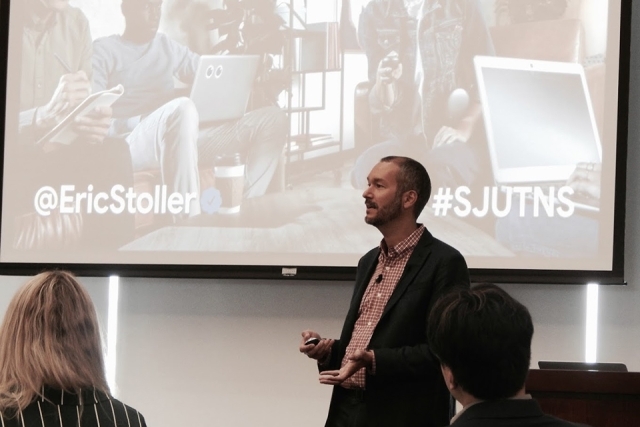
Dynamic advances in digital technology have caused today’s college students to grow up in an educational system that is profoundly different from the ones previous generations experienced. As a result, educators must be able to keep pace with this critical trend if they want to successfully prepare tomorrow’s workforce.
That imperative was underscored throughout St. John’s University’s “Teaching Narratives Symposium: Engaging Digital Learners,” which was held recently in the D’Angelo Center Ballroom, on the Queens, NY, campus. The term “digital learners” refers to students who have spent their formative years immersed in technology and whose way of learning is shaped by this.
“Digital technology is an integral part of the everyday lives of these students, who have never lived in a world where technology was not ubiquitous. As a result, their expectations of a quality learning experience are very different. This challenges us as faculty to continually evolve our pedagogical approaches,” said Cynthia R. Phillips, Ed.D., Director, Center for Teaching and Learning, in welcoming remarks she made to guests who gathered on June 13 for the daylong event.
The second annual symposium brought together St. John’s faculty, administrators, staff, and invited representatives of several neighboring colleges and universities to share stories that highlight teaching practices which promote ways to effectively involve digital learners.
“This symposium provides a very viable avenue for faculty members and stakeholders to get together to evaluate and better understand how we can deliver teaching material in relevant ways to our students,” said Simon G. Møller, Ph.D., Provost and Vice President for Academic Affairs, as he addressed the gathering.
Symposium keynote speaker Eric Stoller, a higher education writer, consultant, and the Student Affairs and Technology blogger for Inside Higher Ed, encouraged the audience to embrace changes fueled by digital technology and to adopt new technologies to enhance the student experience.
“Digital technology,” Mr. Stoller said, “eliminates hierarchy and geographical distance. You can connect your students to people around the globe in a matter of seconds in a very meaningful way.”
“How many of you were taught in a very traditional classroom environment, where someone was standing in front of a chalkboard or a whiteboard?” Mr. Stoller asked his audience. “This is the way many of us were taught, so, this is the way we are comfortable teaching others. There is not necessarily a focus on eliminating this model of teaching, which we know works. The focus is actually on enhancing and accentuating the way we reach today’s learners through the use of digital technology.”
“Some of you are thinking, ‘Oh, my gosh, I have to learn so much,’” continued Mr. Stoller. “But I think that is a good thing. I used to work at a company where the slogan was ‘Always Learning.’ For anybody who works in higher education or at a university or college, that slogan should be the ethos of what you are all about.”
Throughout the symposium, members of the St. John’s faculty led concurrent breakout sessions on ways to incorporate digital technology into the classroom experience. The sessions encompassed topics such as “Utilizing Technology and Media to Navigate Difficult Conversations,” “Creating a Shared Learner Workspace to Explore and Evaluate Research Resources,” and “Kinesthetic Methods that Promote Student Engagement.”
Engaging digital learners through the robust use of digital technology exemplifies St. John’s mission of helping those in need, according to Elizabeth Ciabocchi, Ed.D., Vice Provost for Digital Learning and Executive Director, Online Learning and Services.
“As a Vincentian institution,” she said, “we need to ensure that all of our learners can access our learning environments. Digital technologies certainly can provide that level of equity and accessibility for students who require special accommodations or participate in our courses and programs remotely.”
Related News
St. John’s Breaks Ground on New Basketball Facility and Recreational Upgrades
Construction will soon begin on a new basketball practice facility on St. John’s University’s Queens, NY, campus that serves as the first step in the renovation and modernization of student recreational resources.
New Chief of Public Safety Is at Home at St. John’s
A native of Hamden, CT, Dan Rhone grew up in the heart of BIG EAST Conference culture. When an opportunity emerged to direct the Department of Public Safety at St. John’s University, it was, as the longtime safety official said, a “layup” of a decision—that is, an easy choice.
Annual Move-In Weekend Celebrates the Next Generation of Johnnies
Carrying boxes, carts, and an abundance of enthusiasm, 2,627 resident students moved into St. John’s University’s Residence Village over Labor Day weekend.
